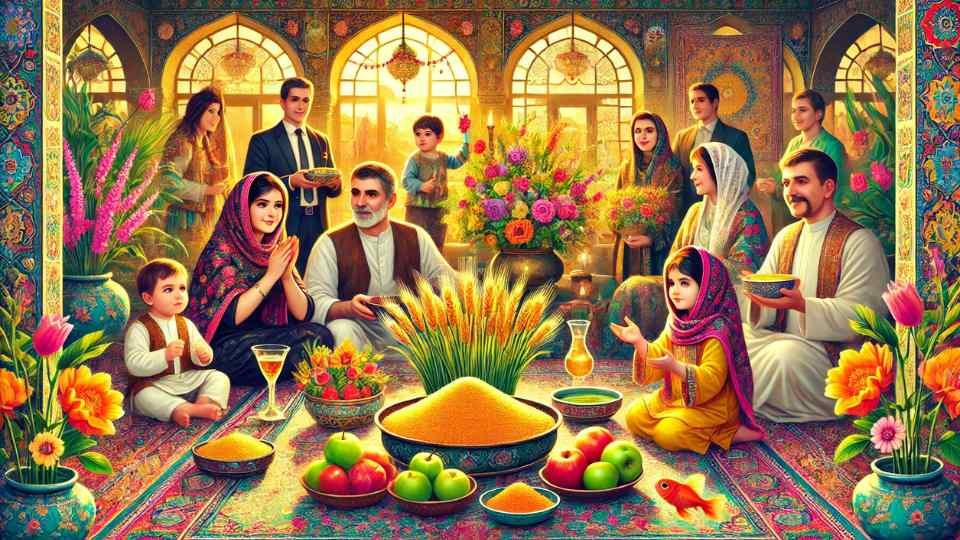
 Zoroastrian New Year (Pateti/Navroz):
Zoroastrian New Year (Pateti/Navroz):


Navroz literally means “New Day” in Persian. While it falls on the spring equinox (around March 21) in Iran, Parsis in India observe it around August 16–17, depending on their calendar.
Pateti, the day before Navroz, is dedicated to self-reflection and repentance. People take this day to look inward, seek forgiveness, and prepare themselves spiritually for the year ahead.
 Why Pateti is Spiritually Important Before Celebrating Zoroastrian New Year
Why Pateti is Spiritually Important Before Celebrating Zoroastrian New Year
The term Pateti comes from the Avestan word patet, which means confession or repentance. It is a sacred day that allows every individual to:



This transforms the Zoroastrian New Year into much more than a festive event — it becomes a day for spiritual renewal and moral rebirth.
 How Do Zoroastrians Celebrate Their New Year?
How Do Zoroastrians Celebrate Their New Year?
Zoroastrian New Year is observed with vibrant customs that blend ancient spirituality with warm cultural expressions. Each ritual has deep meaning and brings families together.
 1. House Cleaning and Decoration
1. House Cleaning and Decoration
To welcome the New Year with a fresh mindset and space:
- Homes are cleaned thoroughly.
- Doors and entrances are adorned with Rangoli and flower garlands.
- Fresh flowers are placed in living spaces to create a soothing and festive vibe.
 2. Visiting Fire Temples
2. Visiting Fire Temples
Families visit Fire Temples (Agiary) where they:
- Offer sandalwood, light sacred lamps (divo), and pray.
- Reflect in silence and connect with the divine through fire, which symbolizes Ahura Mazda’s light and wisdom.
 3. Wearing Traditional Clothing
3. Wearing Traditional Clothing
People dress in clean, preferably white or light-colored clothes symbolizing purity and peace. Children and elders participate equally in rituals and festivities.
 4. Enjoying Traditional Foods
4. Enjoying Traditional Foods
Food plays a central role in the Zoroastrian New Year:
- Ravo (semolina dessert)
- Sev (sweet vermicelli)
- Patra ni Macchi (steamed fish in banana leaf)
- Sali Boti (meat cooked with crispy potato straws)
Each dish is shared with love, served to guests, and enjoyed by family members during New Year gatherings.
 5. Sharing Gifts and Helping the Needy
5. Sharing Gifts and Helping the Needy
- Families exchange dry fruits, sweets, and small presents.
- Donating to the poor and performing acts of kindness are encouraged, following the Zoroastrian principle of “Good Deeds.”
 When is Zoroastrian New Year Celebrated?
When is Zoroastrian New Year Celebrated?
Depending on the calendar used, the date of Zoroastrian New Year varies. Here’s a clear breakdown:
 Calendar Type Calendar Type |
 Community Community |
 Approx. Date Approx. Date |
|---|---|---|
| Shahenshahi | Parsis in India | August 16–17 |
| Kadmi | Traditional Parsi groups | A few days after Shahenshahi Navroz |
| Fasli | Zoroastrians in Iran | March 21 (Spring Equinox) |
Even though dates differ, the core message of starting anew stays the same.
 Key Teachings Honored During Zoroastrian New Year
Key Teachings Honored During Zoroastrian New Year
The Zoroastrian New Year is a perfect time to reconnect with the foundational teachings of the faith:
 Good Thoughts, Good Words, Good Deeds
Good Thoughts, Good Words, Good Deeds
These are the three pillars of Zoroastrianism.
Following them leads to inner peace, family harmony, and social balance.
 Fire: The Symbol of Divine Light
Fire: The Symbol of Divine Light
In Zoroastrianism, fire represents truth, purity, and the light of Ahura Mazda.
During New Year prayers, fire is worshipped with deep devotion.
 Voice Search Optimized Questions and Answers
Voice Search Optimized Questions and Answers
These common questions help people understand the Zoroastrian New Year more clearly:
 What is the Zoroastrian New Year?
What is the Zoroastrian New Year?

 When do Parsis celebrate their New Year?
When do Parsis celebrate their New Year?

 How do Zoroastrians celebrate Pateti?
How do Zoroastrians celebrate Pateti?

 What do Zoroastrians eat during New Year?
What do Zoroastrians eat during New Year?

 How the Zoroastrian New Year is Celebrated Around the World
How the Zoroastrian New Year is Celebrated Around the World
Although the Parsi community in India is one of the largest, Zoroastrians across the globe also celebrate Navroz with equal enthusiasm.
- In Iran, Navroz is a public holiday, celebrated by Zoroastrians and non-Zoroastrians alike.
- In Canada, the U.S., the U.K., and Australia, Zoroastrian associations organize cultural events, communal prayers, and virtual gatherings to stay connected with their roots.
This global connection keeps the spirit of Navroz alive across generations.
 Fun Facts About Zoroastrian New Year
Fun Facts About Zoroastrian New Year
Zoroastrianism is over 3,000 years old.
Fire temples have an eternal flame that never goes out.
Parsis have contributed immensely to Indian business, education, and philanthropy.
Traditional clothing worn on New Year includes the dagli for men and gara sarees for women.
Hospitality is a core value; no guest leaves without being offered food.
 Why Zoroastrian New Year Matters in Modern Times
Why Zoroastrian New Year Matters in Modern Times
Even in today’s digital world, the teachings and traditions of the Zoroastrian New Year offer timeless value:
- Encouraging inner reflection
- Emphasizing personal growth
- Strengthening family bonds
- Practicing gratitude and charity
Celebrating Navroz reminds people to live consciously, love deeply, and give generously.
 Final Thoughts: Celebrate the Zoroastrian New Year with Joy and Purpose
Final Thoughts: Celebrate the Zoroastrian New Year with Joy and Purpose
The Zoroastrian New Year (Navroz/Pateti) is much more than a cultural ritual — it’s a moment to pause, cleanse your heart, and restart your journey with faith, gratitude, and light.
When you greet someone with “Navroz Mubarak”, you’re offering blessings for clarity, kindness, and courage in the coming year.

Navroz Mubarak to all celebrating!

















